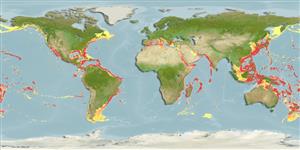Common names from other countries
Environment: milieu / climate zone / depth range / distribution range
Ecologia
Pelágico(a,os,as); intervalo de profundidade 0 - 1234 m (Ref. 83435). Tropical
Indo-Pacific, Western Atlantic and the Mediterranean Sea. Tropical and subtropical.
Length at first maturity / Tamanho / Peso / Idade
Maturity: Lm ? range ? - ? cm Max length : 3.3 cm DL macho/indeterminado; (Ref. 83435)
Filter feeder that strains microscopic organisms such as diatoms from the water (Ref. 866). Suspension feeder (Ref. 109264). Most abundant in the upper 100 m of the open ocean, but also common to the inner neritic zone (Ref. 83534). Dead shells washed up on the beaches (Ref. 88739).
Life cycle and mating behavior
Maturidade | Reprodução | Desova | Ovos | Fecundidade | Larvas
Members of the order Thecosomata are mostly simultaneous hermaphrodites.
Templado, J. and R. Villanueva. 2010. (Ref. 85339)
Status na Lista Vermelha da IUCN (Ref. 130435)
Status no CITES (Ref. 108899)
Not Evaluated
Not Evaluated
Uso pelos humanos
| FishSource |
Ferramentas
Mais informação
Idade/Tamanho
Crescimento
Comprimento-peso
Comprimento-comprimento
Morfologia
Larvas
Abundância
Fontes da internet
Estimates based on models
Preferred temperature
(Ref.
115969): 2.1 - 18.7, mean 10 (based on 1601 cells).
Categoria de preço
Unknown.
